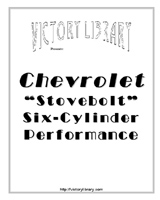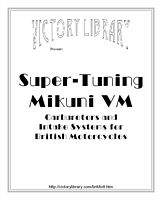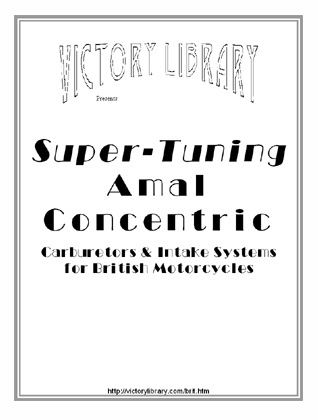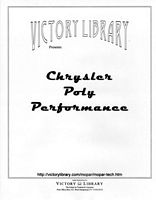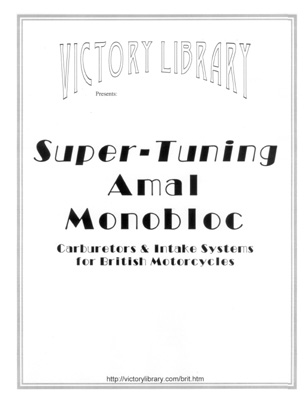
|
 |
Harley-Davidson KR Cam Timing
by Jeffrey Diamond
The Harley-Davidson “K” model engines began in 1952 with fairly mild cam timing. In 1953, an optional dealer-installed cam kit was made available, which was then included in the hotter KK and KHK factory motors. Various grinds have been used for racing over the years, as shown below. Remember that the lift shown is at the lobe and at the valve, since there is no rocker arm ratio.
The KR had lots of R&D spent on it, but they started with a huge handicap: the original cylinder-cam location, inherited from the original 1929 Model “D” engine. Many of the 1953-69 KR lobes are “kidney"-shaped with concave opening flank and normal convex closing flank. Much of the tweaking for gearing, track conditions is in the choice of exhaust which are 30° shorter.
The intake and exhaust cams are gear-driven in train at the same speed, each with 28 teeth (in the small 4-cam engines: D, R, W, G, K, XL), obviously in opposite directions. The #2 rear intake has an extra row to be driven off the pinion gear at 1/2 speed. The cams can be switched (any intakes with any exhausts), but not re-clocked without surgery.
The intake and exhaust cams have the same (nominal, not actual*) separation distance between base circles and lobes as the intake and exhaust stems for each cylinder. However, this only makes the stems parallel to each other, not to the bore axis (22.5° from vertical, rear tilted back + front tilted forward). The tappet positions were not where they wanted the valve seats, but angled fore & aft by 4.5°. This created a pocket in which the seat is recessed (and shrouded) similar to the relief pocket in the Ford V8 and others, but pointed 90° away from helpful!
* These engines followed a well-known engineering principle with regard to roller tappets: the lobe’s side thrust against the roller in the opening phase is very severe and limits maximum values. To alleviate this, they advanced the entire valve train (above the lobe: tappet block, tappet, valve and in OHV pushrod) 1/8” ahead (to the left for CW rotating cams #1 & 3, to the right for CCW cams #2 & 4) of the base circle. This spaces the tappets 1/4” farther apart (1/8” away for each tappet) than the cams, which is the actual stem separation distance.
Now, the rising lobe is directly under the roller, and maximum acceleration, velocity, and thrust angle can be safely increased. On the closing side the angle is worse, but it’s only spring tension, not a mechanical load, and far less important. |
25499-53R |
Duration, Intake |
281° |
Duration, Exhaust |
277° |
Intake Lobe C-Line |
103.5° ATDC |
Exhaust Lobe C-Line |
101.5° BTDC |
Lobe Separation |
102.5° |
Overlap |
74° |
Intake Opens |
37° BTDC |
Exhaust Opens |
60° BBDC
Intake Closes |
64° ABDC |
Exhaust Closes |
37° ATDC
Intake Lift |
? |
Exhaust Lift | ? | | |
25499-55R |
Duration, Intake |
307° |
Duration, Exhaust |
290° |
Intake Lobe C-Line |
98.5° ATDC |
Exhaust Lobe C-Line |
97° BTDC |
Lobe Separation |
97.75° |
Overlap |
103° |
Intake Opens |
55° BTDC |
Exhaust Opens |
62° BBDC |
Intake Closes |
72° ABDC |
Exhaust Closes |
48° ATDC |
Intake Lift |
? |
Exhaust Lift | ? |
“A” (25499-59R) |
Duration, Intake |
324° @ .010” |
Duration, Exhaust |
282° @ .010” |
Intake Lobe C-Line |
82° ATDC |
Exhaust Lobe C-Line |
99° BTDC |
Lobe Separation |
90.5° |
Overlap |
122° |
Intake Opens |
80° BTDC |
Exhaust Opens |
60° BBDC |
Intake Closes |
66° ABDC |
Exhaust Closes |
42° ATDC |
Intake Lift |
.395”? |
Exhaust Lift |
.375”? |
“C” (25499-61R) |
Duration, Front Intake
Duration, Rear Intake |
324° @ .010”
319° @ .010” |
Duration, Exhaust |
282° @ .010” |
Intake Lobe C-Line, F
Intake Lobe C-Line, R |
82° ATDC
84.5° ATDC |
Exhaust Lobe C-Line |
99° BTDC |
Lobe Separation, F
Lobe Separation, R |
90.5°
91.75° |
Overlap, Front
Overlap, Rear |
122°
117° |
Front Intake Opens
Rear Intake Opens |
80° BTDC
75° BTDC |
Exhaust Opens |
60° BBDC |
Intake Closes |
64° ABDC |
Exhaust Closes |
42° ATDC |
Intake Lift |
.395”? |
Exhaust Lift |
.375”? |
“E” (25499-62R) |
Duration, Intake |
316° @ .010” |
Duration, Exhaust |
278° @ .010” |
Intake Lobe C-Line |
88° ATDC |
Exhaust Lobe C-Line |
97° BTDC |
Lobe Separation |
92.5° |
Overlap |
112° |
Intake Opens |
70° BTDC |
Exhaust Opens |
56° BBDC |
Intake Closes |
66° ABDC |
Exhaust Closes |
42° ATDC |
Intake Lift |
.406”? |
Exhaust Lift |
.414” |
“F” (25499-64R) |
Duration, Intake |
312° @ .010” |
Duration, Exhaust |
278° @ .010” |
Intake Lobe C-Line |
90° ATDC |
Exhaust Lobe C-Line |
97° BTDC |
Lobe Separation |
93.5° |
Overlap |
108° |
Intake Opens |
66° BTDC |
Exhaust Opens |
56° BBDC |
Intake Closes |
66° ABDC |
Exhaust Closes |
42° ATDC |
Intake Lift |
.406”? |
Exhaust Lift |
.375”? |
“H” (25499-66R) |
Duration, Intake |
312° @ .010” |
Duration, Exhaust |
280° @ .010” |
Intake Lobe C-Line |
90° ATDC |
Exhaust Lobe C-Line |
98° BTDC |
Lobe Separation |
94° |
Overlap |
108° |
Intake Opens |
66° BTDC |
Exhaust Opens |
58° BBDC |
Intake Closes |
66° ABDC |
Exhaust Closes |
42° ATDC |
Intake Lift |
.440” |
Exhaust Lift |
.440” |
“J” (25499-67R) |
Duration, Intake |
312° @ .010” |
Duration, Exhaust |
285° @ .010” |
Intake Lobe C-Line |
90° ATDC |
Exhaust Lobe C-Line |
102.5° BTDC |
Lobe Separation |
96.25° |
Overlap |
106° |
Intake Opens |
66° BTDC |
Exhaust Opens |
65° BBDC |
Intake Closes |
66° ABDC |
Exhaust Closes |
40° ATDC |
Intake Lift |
.395” |
Exhaust Lift |
.395” |
“J” Intake + “K” Exhaust (25499-69R) |
Duration, Intake |
312° @ .010” |
Duration, Exhaust |
280° @ .010” |
Intake Lobe C-Line |
90° ATDC |
Exhaust Lobe C-Line |
98° BTDC |
Lobe Separation |
94° |
Overlap |
108° |
Intake Opens |
66° BTDC |
Exhaust Opens |
58° BBDC |
Intake Closes |
66° ABDC |
Exhaust Closes |
42° ATDC |
Intake Lift |
.395” |
Exhaust Lift | .395” |
“J” Intake + “L” Exhaust (25498-69R) |
Duration, Intake |
312° @ .010” |
Duration, Exhaust |
285° @ .010” |
Intake Lobe C-Line |
90° ATDC |
Exhaust Lobe C-Line |
102.5° BTDC |
Lobe Separation |
96.25° |
Overlap |
106° |
Intake Opens |
66° BTDC |
Exhaust Opens |
65° BBDC |
Intake Closes |
66° ABDC |
Exhaust Closes |
40° ATDC |
Intake Lift |
.395” |
Exhaust Lift |
.395” |
|
|





